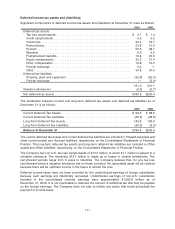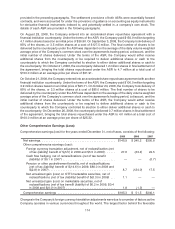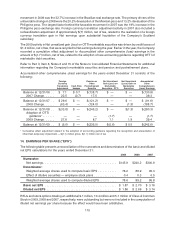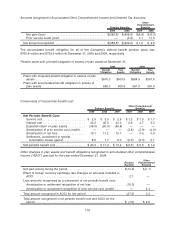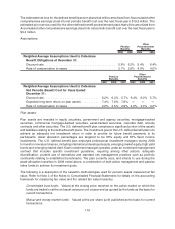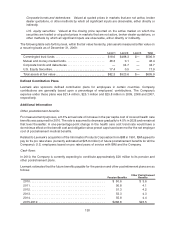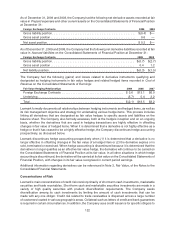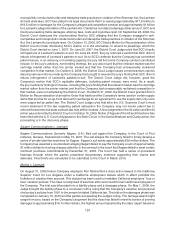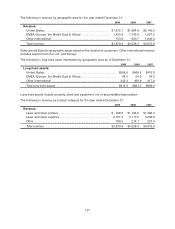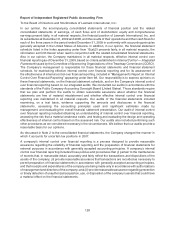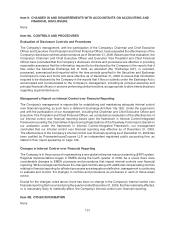Lexmark 2009 Annual Report Download - page 127
Download and view the complete annual report
Please find page 127 of the 2009 Lexmark annual report below. You can navigate through the pages in the report by either clicking on the pages listed below, or by using the keyword search tool below to find specific information within the annual report.
16. DERIVATIVES AND RISK MANAGEMENT
Derivative Instruments and Hedging Activities
Lexmark’s activities expose it to a variety of market risks, including the effects of changes in foreign
currency exchange rates and interest rates. The Company’s risk management program seeks to reduce
the potentially adverse effects that market risks may have on its operating results.
Lexmark maintains a foreign currency risk management strategy that uses derivative instruments to
protect its interests from unanticipated fluctuations in earnings caused by volatility in currency exchange
rates. The Company does not hold or issue financial instruments for trading purposes nor does it hold or
issue leveraged derivative instruments. Lexmark maintains an interest rate risk management strategy that
may, from time to time use derivative instruments to minimize significant, unanticipated earnings
fluctuations caused by interest rate volatility. By using derivative financial instruments to hedge
exposures to changes in exchange rates and interest rates, the Company exposes itself to credit risk
and market risk. Lexmark manages exposure to counterparty credit risk by entering into derivative financial
instruments with highly rated institutions that can be expected to fully perform under the terms of the
agreement. Market risk is the adverse effect on the value of a financial instrument that results from a
change in currency exchange rates or interest rates. The Company manages exposure to market risk
associated with interest rate and foreign exchange contracts by establishing and monitoring parameters
that limit the types and degree of market risk that may be undertaken.
Lexmark uses fair value hedges to reduce the potentially adverse effects that market volatility may have on
its operating results. Fair value hedges are hedges of recognized assets or liabilities. Lexmark enters into
forward exchange contracts to hedge accounts receivable, accounts payable and other monetary assets
and liabilities. The forward contracts used in this program generally mature in three months or less,
consistent with the underlying asset and liability. Foreign exchange forward contracts may be used as fair
value hedges in situations where derivative instruments expose earnings to further changes in exchange
rates. Although the Company has historically used interest rate swaps to convert fixed rate financing
activities to variable rates, there were no interest rate swaps outstanding as of December 31, 2009.
Net outstanding notional amount of derivative activity as of December 31, 2009 was $15.8 million. This
activity was driven by fair value hedges of recognized assets and liabilities primarily denominated in the
Euro, Australian Dollar and South African Rand.
Long (Short) Positions by Currency December 31, 2009
EUR . . . . . . . . . . . . . . . . . . . . . . . . . . . . . . . . . . . . . . . . . . . . . . . . . . . . . . . . . . . $(62.7)
AUD . . . . . . . . . . . . . . . . . . . . . . . . . . . . . . . . . . . . . . . . . . . . . . . . . . . . . . . . . . . 25.4
ZAR . . . . . . . . . . . . . . . . . . . . . . . . . . . . . . . . . . . . . . . . . . . . . . . . . . . . . . . . . . . 11.7
Other Net . . . . . . . . . . . . . . . . . . . . . . . . . . . . . . . . . . . . . . . . . . . . . . . . . . . . . . . 9.8
Total . . . . . . . . . . . . . . . . . . . . . . . . . . . . . . . . . . . . . . . . . . . . . . . . . . . . . . . . . . . $(15.8)
Accounting for Derivatives and Hedging Activities
All derivatives are recognized in the Consolidated Statements of Financial Position at their fair value. Fair
values for Lexmark’s derivative financial instruments are based on pricing models or formulas using
current market data, or where applicable, quoted market prices. On the date the derivative contract is
entered into, the Company designates the derivative as a fair value hedge. Changes in the fair value of a
derivative that is highly effective as — and that is designated and qualifies as — a fair value hedge, along
with the loss or gain on the hedged asset or liability are recorded in current period earnings in Cost of
revenue on the Consolidated Statements of Earnings. Derivatives qualifying as hedges are included in the
same section of the Consolidated Statements of Cash Flows as the underlying assets and liabilities being
hedged.
121


